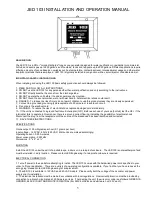
Installation and Operation Manual
Page 18 of 156
[PVI-XXX.0-YY(-TL) - Rev:1.0]
3.
GENERAL INFORMATION AND FEATURES OF A PHOTOVOLTAIC
SYSTEM
The purpose of this chapter is to provide the user of "AURORA PVI-XXX.0 (-TL)" general information
concerning the photovoltaic systems that transform solar energy into electrical energy, usable in
the distribution grid.
3.1.
Photovoltaic energy
In the process of energy conversion, for many years, industrial companies (great energy
consumers) have been experimenting with forms of energy saving and lower emission of
pollutants, through a prudent and rational use of known resources and the research of new forms
of clean and inexhaustible energy.
Renewable energy sources provide a major contribution to solving the problem. In this context, the
exploitation of solar energy to generate electricity (photovoltaic) is becoming increasingly
important worldwide.
Photovoltaic energy represents an enormous advantage in terms of environmental protection
because the solar radiation we receive from the sun is directly converted into electricity without
any combustion process and without the production of nature-polluting waste.
Photovoltaic panels convert the energy radiated by the sun into electrical energy of "DC" type (by
means of a photovoltaic field, also called a PV generator). In order to supply the distribution grid so
this electricity can be used, it should be converted into alternating current "AC". This conversion,
known as DC to AC conversion, is carried out efficiently by the AURORA inverters without the use
of rotating elements, but only by means of static electronic devices.
When used in parallel with the grid, the alternating current output from the inverter flows directly
through the insulation transformer (where required) into the industrial distribution circuit,
connected in turn to the public distribution grid.
If the supply from the photovoltaic field is low, the amount of energy necessary to guarantee the
normal operation of the connected appliances is taken from the public distribution grid. However,
if the opposite occurs, i.e. a surplus of energy is produced, it is directly introduced in the grid, thus
becoming available for other users.
In compliance with local and national regulations, the energy produced can be sold to the
distribution grid or credited against future consumption, thus producing energy savings.
















































